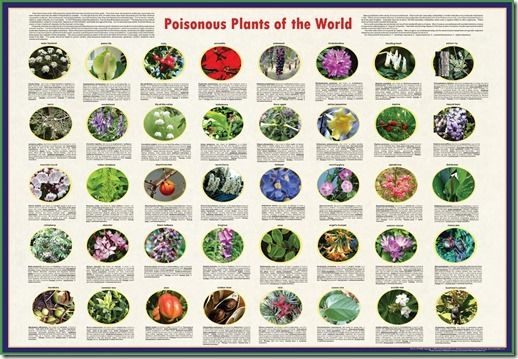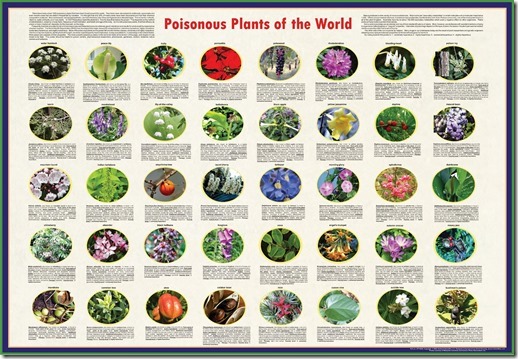
Poisonous Plants: A Garden Designers Guide
A Garden Designer’s Guide To Poisonous Plants
On average, two gardeners a year die in the UK as a result of poisonous plants. There are poisonous plants lurking in almost every garden, dangerous to humans and animals alike. Many poisonous plants are far from obvious except to the expert. Those discussed in this blog are by no means exhaustive, but illustrate a range of concerns that should be foremost in the designer’s mind.
You need always to be sensitive to these dangers, whoever your clients may be and especially if they have young children or pets. Awareness is also in the interests of your own health and safety when designing and working with plants. A surprisingly large percentage of plants are toxic or poisonous to handle or eat.
Even the humble potato is poisonous when raw and cooking will not eliminate the poisonous green parts. The milky sap of the beautiful euphorbias (spurge) will burn and blister skin and will send you to a hospital if you should get it into your eyes. Always make sure that your clients know they should wash their hands and those of their children, after handling plants or playing in the garden.
If ‘ mushrooms’ appear in the lawn they are probably not the edible fungus that is tray packed in the supermarket. Don’t eat them. Some of the most bewitching plants are the most deadly and therefore particularly dangerous to small children who want to pick ‘the pretty flower’ and even put it in their mouths.
Digitalis (foxgloves) with their purple, pink, yellow and white flowers are attractive to bees but poisonous to humans. As is the exquisite blue Aconitum (monkshood), sometimes found growing wild in shady chalk soils. Dainty, dancing aquilegias, and the stunning range of irises are also highly poisonous. So too are winter-flowering Lenten roses (hellebores).
The delicate blue pulsatillas (pasqueflowers) and moisture-loving, spring flowering, golden Caltha palustris (kingcups). Often planted at the margins of ponds and found growing wild in wetland meadows.
There are several trees with poisonous fruits, flowers or berries. The most well-known being Laburnum (golden chains). With its gorgeous, abundant, pendulous yellow flowers it has been an extremely popular garden tree. Its brown seed pods contain shiny black seeds containing strychnine!
The delightful coloured berries that the birds love are frequently poisonous to humans. Including those of the silver-leaved Hippophae rhamnoides (sea buckthorn). In wilder or untended parts of the garden, there will almost certainly be familiar stinging nettles, and hogweed, which will blister and irritate the skin.
If garden boundaries abut pastures where sheep, cattle or horses graze, not only should these boundaries be stock proofed, but beware of planting poisonous hedging or other plants that can be reached by inquisitive livestock.
They will lean over, pluck and chew indiscriminately on anything that looks enticing within a metre of the boundary. The leaves and fruits of conifers such as Juniperus (juniper) are poisonous to cattle and humans.
So to, the wonderful Taxus (yew) which forms such a marvellous, dense hedging and is invaluable in the creation of formal gardens. There are many other shrubs and perennial weeds that are toxic to cattle and horses. Ragwort, seen all too often in neglected fields, common ligustrum (privet) hedging and hedera (ivy) are just a few.
Be a responsible designer and check online for a number of excellent books on poisonous plants.
Common Poisonous Plants | ||
Latin Name | Common Name | Poisonous Parts |
Aconitum Spp. | Aconite | All |
Agapanthus Orientalis | Agapanthus | Sap |
Alder Buckthorn | Alder Buckthorn | |
Anthurium Spp. | Anthurium | |
Malus Sylvestris | Apple Tree | Seeds |
Zantedeschia Aethiopica | Arum Lily | All parts, especially berries. |
Asparagus Officinalis | Asparagus | Small red berries. |
Autumn Crocus | All plant and bulb | |
Rhododendron Spp. | Azalea | All |
Gypsophila Paniculata | Baby’s Breath | |
Helleborus Foetidus | Bearsfoot Hellebore | |
Fagus Spp. | Beech | |
Prunus Dulcis | Bitter Almond | Kernels |
Robinia Pseudoacacia | Black Locust | All except flowers. The bark is very toxic. |
Dicentra Spectabilis | Bleeding Heart | Foliage and Roots |
Sanguinaria Canadensis | Bloodroot | All |
Blue Bell | ||
Echium Spp. | Blue Devil | |
Scilla Spp. | Blue Squill | |
Buxus Sempervirens | Boxwood | All |
Cytisus Scoparius. | Broom | Seeds, especially if chewed before swallowing. |
Aesculus Parviflora | Buckeye Bottlebrush | |
Euonymus Spp. | Burning Bush | |
Zantedeschia Aethiopica | Calla Lilly | Leaves |
Menispermum Canadense | Canada Moonseed | |
Euphorbia Lactea | Candelabra Cactus | |
Euphorbia Lathyris | Caper Spruge | |
Lobelia Spp. | Cardinal Flower | |
Lobelia Spp. | Cardinal Flower Blue | |
Dianthus Spp. | Carnation | |
Gelsemium Sempervirens | Carolina Jessamine | |
Ricinus Communis | Castor Bean | All |
Nepeta Cataria | Catnip | Stems and leaves |
Apium Graveolens | Celery | |
Ranunculus Sceleratus | Celery-leaved Buttercup | All especially leaves. |
Cherry | Kernels | |
Prunus Laurocerasus | Cherry Laurel | Kernels |
Abutilon Hybridum | Chinese Bellflower | |
Abutilon Hybridum | Chinese Lantern | All |
Toxicodendron Vernicifluum | Chinese Lacquer Tree | All |
Sophora Japonica | Chinese Scholar Tree | |
Dioscorea Batatas | Chinese Yam | |
Solanum Pseudocapsicum | Christmas Cherry | All |
Euphorbia Pulcherrima | Christmas Flower | |
Helleborus Niger | Christmas Rose | All |
Chrysanthemum | Leaves and Stem | |
Clematis Spp. | Clematis | All |
Symphytum Officinale | Comfrey | |
Helleborus Lividus | Corsican Hellebore | All |
Cotoneaster | Red Berries | |
Cyclamen | Flowers | |
Narcissus spp. | Daffodil | Bulbs |
Daphne | All but especially berries. | |
Day Lily | ||
Delphinium spp. | Delphinium | All |
Lilium Longiflorum | Easter Lily | Leaves, stems and flowers |
Echium | ||
Sambucus Nigra | Elderberry | All, especially roots and berries. |
Alocasia Brisbanensis | Elephant Ears | All |
Hedera Helix L. | English Ivy | Leaves and berries. |
Taxus Baccata | English Yew | Foliage, Berries, bark, seeds. |
European Spindle | ||
Robinia Pseudoacacia | False Acacia | All except flowers. The bark is very toxic. |
Festuca Arundinaceae | Fescue | |
Digitalis Purpurea | Foxglove | All including water from cut flowers |
Geranium | ||
Heracleum Mantegazzianum | Giant Hogweed | |
Gladiolas | ||
Gloriosa Superba | Glory Lily | All, especially tuberous roots. |
Hellebore | ||
Ilex Aquifolium | Holly | Berries, Rest of Tree |
Honeysuckle | All, specially Berries | |
Equisetaceace | Horse Tail | All |
Aesculus Hippocastanum | Horse Chestnut | Buds, nuts, leaves, bark, seedlings, honey. Conkers |
Hyacinth Orientalis | Hyacinth | Bulb |
Hydrangea | ||
Papaver Nudicaule | Iceland Poppy | All, especially sap. |
Iris | Tubers | |
Hedera Heliz | Ivy | All including blackberries. |
Euonymus Japonicus | Japanese Spindle Tree | Berries and Seeds |
Jasmine | Sap and Berries | |
Juniper | ||
Laburnun Anagyroides | Laburnum | Black Seeds if they are chewed or crushed. |
Laurel | All | |
Lenton Rose | ||
Leyland Cypress | ||
Convallaria mejalis | Lily of the Valley | All |
Lupinus Perennis | Lupìne | All especially pods with seeds. |
Phoradendron Villosum | Mistletoe | Berries, leaves and stems |
Aconitum Napellus | Monkshood | All, especially roots. |
Ipornoea | Morning Glory | Seeds |
Quercus Spp. | Oak Tree | Foliage and Acorns |
Nerium Oleander | Oleander | All, if used as cut flowers water too. |
Orange Day Lily | ||
Solanum Spp | Ornamental Pepper | All |
Pastinaca Sativa | Parsnips | |
Peace Lily | All | |
Philodendron Scandens | Philodendron | All, including roots. |
Poppy | ||
Solanum Tuberosum | Potatoes | All including tubers, sprouts and unripe berries. |
Ligustrum Ovalifolium | Privet | Berries |
Trifolium Pratense | Red Clover | All |
Red Maple | Leaves, especially dried. | |
Quercus Rubra | Red Oak | Buds, young shoots, sprouts, acorns. |
Rhododendron Simsii | Rhododendron | All |
Rheum Rhabarbarum | Rhubarb | Leaves |
Ruta Graveolus | Rue | |
Schefflera | ||
Skunk Cabbage | ||
Cotinus | Smoke Bushes | Sap in stems, shoots and leaves. |
Symphoricarpos Albus | Snowberry Bush | Berries |
Saponaria Officinalis | Soapwort | All especially seeds and roots. |
Spartium Junceum | Spanish Broom | Seeds, especially if chewed before swallowing. |
Euonymus Europaeus | Spindle Tree | Pink Fruits, All tree |
Euphorbia Lathyris | Spurge Laurel | White Sap |
Hordeum Jubatum | Squirreltail Barley | Seedheads |
Senecio Jacobaea | Staggerweed | All |
Star of Bethlehem | Bulbs | |
Iris Foetidissima | Stinking Iris | Orange seeds inside the fruit. |
Toxicodendron Succedanea | Sumacs | |
Festuca Arundinacea | Tall Fescue | Seed head, stem and leaf. |
Senecio Jacobaea | Tansy | All |
Tulipa Spp. | Tulip | |
Catharanthus Roseus | Vinca Rosea | |
Parthenocissus Quinquefolia | Virginia Creeper | Berries, leaves. |
Wild Cherrry | Leaves, Bark, Cherries | |
Prunus Serotina | Wild Black Cherry Tree | Twigs and leaves. |
Helleborus Niger | Winter Rose | All |
Wisteria Sinensis | Wisteria | All, especially seeds and pods. |
Taxus Baccata | Yew | Foliage, Berries, bark, seeds. |
For more information on poisonous plants or if you are looking to train as a professional garden design see our online courses here

